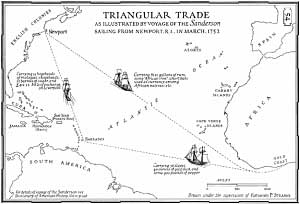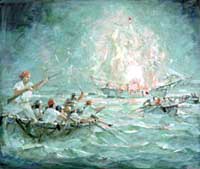 | |||||
 |
History and CultureColonial AmericanImmigration:Europeans, mostly from England, and slaves from Africa were the two groups immigrating to the lands near Narragansett Bay in the 1600s. Rhode Island's first permanent settlement was at the head of the Narragansett Bay in 1636 founded by Roger Williams. Trade:During the Colonial times, Narragansett Bay was used as a passage for trade. It was an easier route for ships to navigate the Long Island sound between Rhode Island and NY than to sail around Cape Cod. The Bay was strategically located in relation to the coastal communities to the north and south for coastal trade and was a convenient departure point for overseas commerce. Maritime trade became the first business of any significance to the colony and shipbuilding was its first manufacturing industry. Newport, Rhode Island became one of Colonial America's best harbors and most prosperous port cities. The Bay also contained half a dozen small harbors in coves and river mouths that were suitable for the building and launching of ships and the docking of merchant vessels. Rhode Island became part of the slave trade and was involved in the triangular trade where molasses was brought from the West Indies to Rhode Island. It was then transformed into rum and bartered along the African coast for slaves. The slaves were then carried back to Rhode Island, the West Indies or Southern colonies.
 "Triangular Trade, voyage of the Sanderson from Newport, RI, 1752" (Click for full version of map) Indirect contact between the colonies and China was made through Dutch merchants from the time of the first settlements along Narragansett Bay. There are records of direct shipments of Chinese porcelains from the Netherlands to Newport. Colonists later began trading directly with China and over a period of sixty years, there were more than seventy-five voyages made to China from the Narragansett Bay. Items such as tea, porcelain and silk were all brought to the colonies from China. Narragansett Bay was also port to over 50 vessels that were used for commercial whaling. The first whaler in Rhode Island was probably the sloop Alicia that was sent out in 1733 by Benjamin Thursten of Newport. The major export item from these whales was spermaceti candles that were made from the head matter of whales. Military:In the late 18th century, more than half of all Rhode Island vessels were engaged in smuggling tea. An armed British vessel, HMS Gaspee was on patrol in the Narragansett Bay to catch those ships that were smuggling tea, but, due to the many coves and inlets of the Bay, many vessels were able to avoid the HMS Gaspee. However, on June 9, 1772, the Gaspee, followed merchant John Brown's boat into shallow water. Although the Gaspee was the hunter, it soon became the hunted when it was boarded, captured, and burned while crowds gathered on the wharf to cheer. 
(Click for larger image) Courtesy of the Gaspee Days Committee Toward the end of 1700s, the British were controlling areas along the Narragansett Bay. Early in the Revolution, a portion of the British fleet used Narragansett Bay as their base of operations in their blockade of the Atlantic coast. During the war, fortifications were built on land around Narragansett Bay in Newport to protect the colonists. In 1778, the French and Americans planned an attack on Newport against the British. The British evacuated Newport voluntarily and the French then occupied the city until 1781. Slavery:Narragansett, Rhode Island held the highest slave percentage in all of New England during the Colonial era. Slaves that were brought over from Africa through the triangular trade were used on the farm plantations of South County. They also worked in domestic services in the mansions of the merchants. Natural ResourcesNarragansett Bay provided the colonists with food. Shellfish and fish were plentiful and became part of the colonists diets. Sturgeon, a large fish caught by the colonists, is no longer a species found in the Bay today. Lobsters and seaweeds were so plentiful they were used as fertilizer for the large South County farms.
Top of Page
|
||||